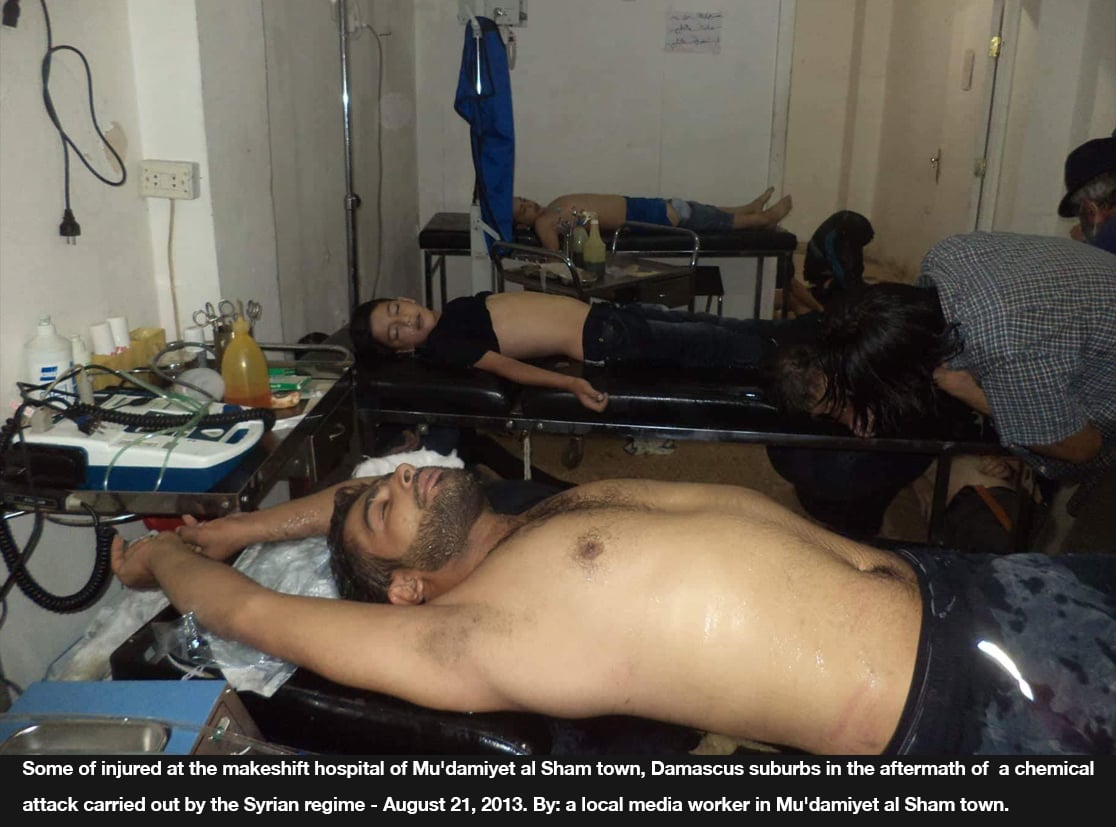The Syrian Regime Has Carried out 216 Chemical Attacks, including 183 Attacks after the Attack on Ghouta

As five years have passed since the most heinous chemical attack the Syrian people has ever known, the pain, even after five years, is still deeply rooted not only because the criminal is still ruling Syria, but also because he followed his crime with hundreds of other attacks.
In its report that was released today which marks the 5th anniversary of the Ghouta massacre, SNHR has outlined the data for 221 incidents of chemical weapons use by the Syrian regime and ISIS. Of those, the Syrian regime carried out 216 attacks, including 183 attacks after the Ghouta attack. The reports can be found on the following URL:
Even though SNHR hasn’t been able to conduct special analysis such as analyzing soil and blood samples from the areas that saw chemical attacks, the report sheds light on the documentation methodology adopted by SNHR that included extensive analysis that tackled the course of the attack and drawing out an understanding of the form and pattern of the attack based on accounts, as well as pictures and videos, in addition to charting vertical and horizontal designs that show the location where the shells landed and their effects.
The report outlines the Syrian regime’s use of chemical weapons in light of Security Council Resolution, as the report notes that 33 chemical attacks were carried out by the Syrian regime before Security Council Resolution 2118, 183 attacks between the date on which Resolution 2118 was adopted and August 21, 2018, including 114 attacks after Security Council Resolution 2209 and 58 attacks after Resolution 2235.
According to the report, these attacks resulted in the killing of no less than 1,461 individuals who were all killed in attacks by the Syrian regime. Of those, 1,397 were civilians, including 185 children and 252 women (adult female), 57 were armed opposition fighters, and seven were captives from Syrian regime forces who were being kept at an opposition prison. In addition, no less than 9,753 individuals were injured.
The report notes that the Syrian regime carried out its second-largest chemical attack in Khan Sheikhoun city, southern suburbs of Idlib governorate nearly three years after the Ghouta attack as an inevitable outcome of the sense of immunity afforded by the international community’s leniency towards the Syrian regime’s violations. This marked the international community’s failure, the report stresses, to commit to implementing its resolution which incited the Syrian regime to repeat its chemical attacks on multiple occasions, the most recent of which was the two attacks on Douma in April 2018.
According to the report, the Syrian regime carried out 169 chemical attacks between the Ghouta attack in Damascus suburbs in August 2013 and Khan Sheikhoun attack in Idlib governorate in April 2017. Also, the Syrian regime carried out 14 chemical attacks between the attack on Khan Sheikhoun in Idlib governorate in April 2017 and the two attacks on Douma city in Damascus suburbs governorate in April 2018.
The report sheds light on a number of important points with respect to the two Ghoutas attack, such as the timing of the attack which ensured a still air movement and sutiable temperature that was optimal for the spreading of the gas. In addition, the report notes that 13 rockets were fired from special launchers. All of this indicates a deliberate intention on the Syrian regime’s part to kill as many victims as possible and create shocking sense of extermination in order to submit the Syrian people into surrendering once and for all so they chose to go back to the degrading family rule for the rest of their days.
The report notes that the Ghouta chemical attack resulted in the killing of no less than 1,127 individuals, including 107 children and 201 women (adult female). In addition, about 5,935 individuals were injured.
Moreover, the report notes that the OPCW member states meeting at the Hague agreed, on June 28, 2018, to give the organization the authority to identify the perpetrators of chemical attacks in Syria after the OPCW’s mandate was limited to determining whether there have been chemical attacks or not without pinpointing responsibility. The report regards this decision as a pivotal step towards holding the criminals who used chemical gases against civilians accountable, especially after Russia had ended the mandate of the JIM on November 17, 2017, as it was the one charged with this task.
The report stresses that the Syrian regime has, through the use of chemical weapons, violated the customary international humanitarian law, the CWC, and all relevant Security Council Resolutions, particularly, Resolutions 2118, 2209, and 2235. Also, the use of chemical weapons constitutes a war crime according to the International Criminal Court’s Rome Statute.
The report also notes that the Russian government has ratified the CWC which strictly prohibits any form of assistance or encouragement on the contribution to any prohibited activity by any member state. However, a number of evidences suggest that Russian forces were involved in providing a preliminary and subsequent assistance to Syrian regime forces in a number of attacks. Further, Russia has used 12 vetoes during the Syrian crisis in favor of the Syrian regime, including six vetoes on the chemical weapons issue in particular which led, according to the report, to the Security Council’s complete and utter failure in protecting the international law and the international order.
The report calls on the international community to form a humanitarian, civilized alliance that aims to protect the Syrian civilians from chemical weapons and all the patterns of killing that they have experienced over the course of the last eight years. Also, victims should be compensated, and the most pressing compensation process is holding the Syrian regime accountable for the crimes against humanity it committed against the Syrian people. Only then, this alliance can lead a political process that aims to achieve a fair stability.


